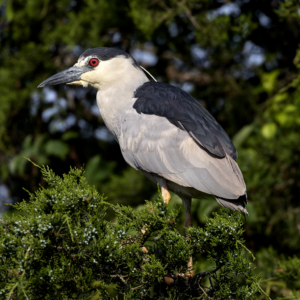 The closest thing that we have to an annual physical for our nature preserve is the summer bird count. It’s been done every year since the mid-1960’s, at a time before the founding of Woodland Dunes. Simply put, it’s an attempt to record the birds that live here during the nesting season. Some places do nesting surveys, during which observers try to carefully document bird nesting during the summer. Ours is not aimed at confirming nesting, but we assume that the birds that we document here during the season are most likely in the process of nesting. It would be difficult and very time consuming to document nests for all the birds we encounter here, so records of their presence will have to do.
The closest thing that we have to an annual physical for our nature preserve is the summer bird count. It’s been done every year since the mid-1960’s, at a time before the founding of Woodland Dunes. Simply put, it’s an attempt to record the birds that live here during the nesting season. Some places do nesting surveys, during which observers try to carefully document bird nesting during the summer. Ours is not aimed at confirming nesting, but we assume that the birds that we document here during the season are most likely in the process of nesting. It would be difficult and very time consuming to document nests for all the birds we encounter here, so records of their presence will have to do.There are still many species of birds in Wisconsin in summer, but probably not as many of them as there used to be. The purpose for the establishment of our nature preserve was to also preserve the habitats of birds. Of course in doing so, many other species of plants and animals also benefit.
Back in the early days, birds would be counted as observers walked a more or less predetermined route. The species and numbers of birds were recorded, and locations of the birds were actually mapped, along with other wildlife observations. This resulted in incredibly detailed records which have yet to be compiled and interpreted. Later, as our workload increased, we began to survey at specified points within the preserve, about 30 in all, visiting each of them at least once during early summer, observing and listening for a 10 minute period. If walking from point to point, we also record any additional birds heard along the way. Of course, not all birds present are seen or heard at a specific time, so additional visits to points are good, but often hard to schedule.
In typical years we record 90 to 100 or so species of birds on summer counts, sometimes more. This number reflects the quality of the habitat within the preserve, and the diversity of habitats themselves. Woodland Dunes consists of more than 1500 acres of forest, shrubland, grassland, and wetlands, and within those a number of microhabitats. They intermingle with one another depending on wetness and maturity of the vegetation. The cooling effect of Lake Michigan gives our area a northern feel in terms of plants, and we have extensive marsh and sedge meadows, shrub-carr wetlands, and moist forest on the dry old beach ridges, and swamp forest in the wetland swales. Such areas are too complex to recreate if they are destroyed- they need to be preserved and carefully managed.
So what birds do we find here? During the marsh survey today we found sedge and marsh wrens, sora and Virginia rails, Caspian tern, great blue, green, and black-crowned night herons, swallows, swamp sparrows, and lots of blackbirds. In the forest we find peewees and great-crested flycatchers, Canada and black-throated green warblers, waterthrushes, wrens, wood thrushes, and white-throated sparrows. In the grasslands we find meadowlarks, bobolinks, dickcissels, savannah, grasshopper, and Henslow’s sparrows. In the shrublands in between, indigo buntings, catbirds, yellow, yellowthroat, and redstart warblers, and wrens and robins. Obviously this isn’t all of the birds we have, but you can almost tell which habitat you are in even if you’re eyes are shut, but the birds you hear.
Someday, some very patient researcher will comb through these records to look at the changes in our bird populations over time. In the meantime, we’ll continue to document as best we can our bird populations, and while doing so walk the trails and assess vegetation and look for ways in which we can help the wildlife in our preserve. The resulting “to-do” list is long enough to keep us busy until we do it again next year!
photo- Black-crowned Night Heron by Charles Homler d/b/a Focus On Wildlife – Own work, CC BY-SA 4.0, https://commons.wikimedia.org/w/index.php?curid=118456702
